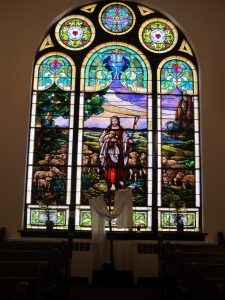History of Our Church
 St. Paul’s Evangelical Lutheran Church, founded in 1855, has a rich history. The church is easily recognized by its location at the “top of the hill” on the main route through Dillsburg. Three larger-than-life stained glass windows, along with many single stained-glass windows, give the building its character and charm. However, the real personality of the church is shaped by the people who gather for worship, Christian Education, outreach projects, and other ministries that serve in the name of Jesus Christ.
St. Paul’s Evangelical Lutheran Church, founded in 1855, has a rich history. The church is easily recognized by its location at the “top of the hill” on the main route through Dillsburg. Three larger-than-life stained glass windows, along with many single stained-glass windows, give the building its character and charm. However, the real personality of the church is shaped by the people who gather for worship, Christian Education, outreach projects, and other ministries that serve in the name of Jesus Christ.
Most church histories begin with the date of incorporation, which for St. Paul’s was April 4, 1857. However, our history is unique because, prior to organization, the congregation built and dedicated a church building on November 16, 1856. Additionally, the founding of the congregation traces to March 5, 1855, the date when the first pastor, the Rev. Joseph R. Focht, accepted a call to the Dillsburg Lutheran Charge.
Certainly the years of history form the foundation of the church. A detailed account of the church’s history is available upon request. The first 36 years were marked by searches for a new pastor. On June 18, 1913, the most destructive fire in the history of the community consumed eight buildings, including the church and the parsonage. The congregation met this challenge with determination and voted to build on the present site, which was a lot purchased in April 1909. The present church was dedicated on Sunday, September 13, 1914, fifteen months after the fire.
The congregation has experienced periods of varied growth under different pastoral leadership, carrying the congregation through challenging times.
More recent history is marked by difficult decisions to forego a major building expansion and to focus on renovations to the current structure. In preparation for the 100th year celebration, the Chancel and Choir areas were renovated in February 2014. In August 2014, Chuck Rhodes from abc27’s “Let’s Go Places” visited St. Paul’s and did a story about the renovation and 100th Anniversary. You can view a video of the broadcast and read more about it.
The congregation celebrates and nurtures the call of members to positions of ministry on the roster of the ELCA. The Rev. Roy Stetler, currently serving Quickel Lutheran Church, in York County, was ordained on August 8, 2009. Sister Cynthia Jones, a member of the ELCA Deaconness community, graduated from the Lutheran Theological Seminary at Gettysburg in May 2010. George Scott graduated from the Lutheran Theological Seminary at Gettysburg on May 17, 2013 and has served various parishes in the Lower Susquehanna Synod. Ursula Schreffler graduated from the Lutheran Theological Seminary at Gettysburg on May 16, 2014 and was ordained on June 6, 2014 at the annual Assembly of the Lower Susquehanna Synod and accepted a call to Zion Lutheran Church, Union Deposit, PA.
The Congregation Council has been involved in active renewal efforts over the past four years, completing the Synod’s “Readiness for Renewal” Program and appointing a Renewal Team to examine the mission and ministry of St. Paul’s. Out of their efforts, a new mission phrase was developed: “Being Renewed in Christ.”
New efforts of outreach and community engagement have increased the visibility and impact of the congregation in the Dillsburg Area. A Seniors Ministry was just getting started before the pandemic hit. Our live-streamed services have reached into many homes both in our area and beyond.
The future of St. Paul’s look promising as we seek to live up to our commitment of “Being Renewed in Christ.”
History of the ELCA
The Evangelical Lutheran Church in America was formed over 30 years ago. This new church was formed from three separate and well-established North American church bodies:
- The American Lutheran Church
- The Association of Evangelical Lutheran Churches, and
- The Lutheran Church in America.
Beginning January 1, 1988, these churches, with shared beliefs and missions, officially formed the ELCA. Two decades later, this energized church is composed of approximately 4 million members who reside within its 65 Synods and nearly 8,900 congregations across the U.S. and Caribbean. Today, the ELCA reflects the rich and diverse heritage of the people it serves.
But to understand our heritage fully, one must trace our roots back through the mid-17th century, when early Lutherans came to America from Europe, settling in the Virgin Islands and the area that is now known as New York. Even before that, Martin Luther sought reform for the church in the 16th century, laying the framework for our beliefs.
